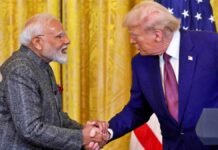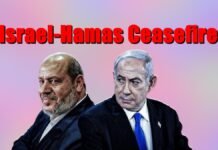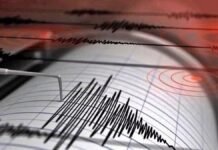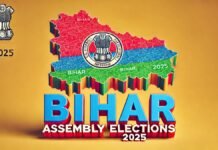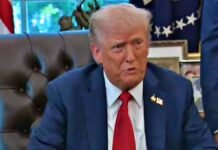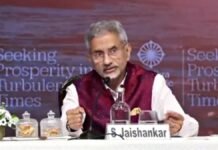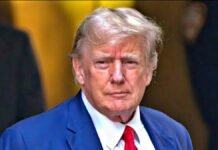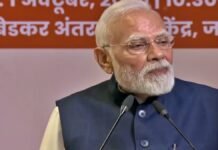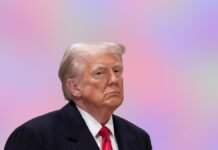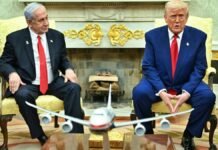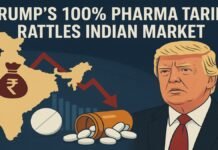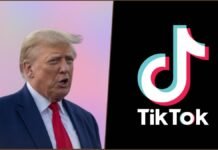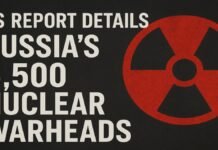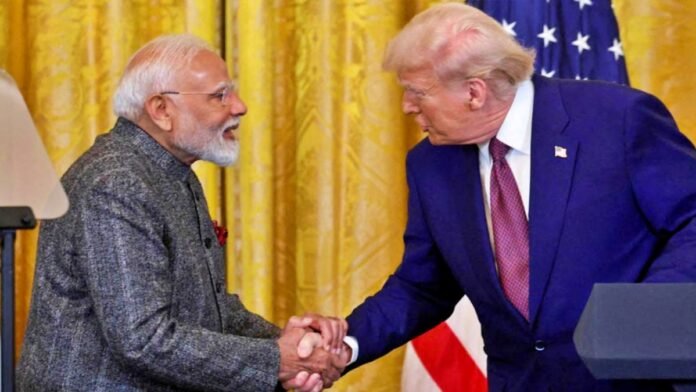
Key Points
- PM Narendra Modi spoke with President Donald Trump on Thursday, October 9, 2025
- Modi congratulated Trump on historic Israel-Hamas Gaza ceasefire and hostage release agreement
- Both leaders reviewed “good progress” in ongoing bilateral trade negotiations between India and US
- Second phone conversation between the two leaders in less than a month
- Previous call was on September 17, 2025 when Trump wished PM Modi on his birthday
- Leaders agreed to maintain close contact in coming weeks as trade talks advance
- Trump’s Gaza peace deal announced October 8, 2025, includes hostage releases and humanitarian aid
- Trump scheduled to visit Jerusalem on Sunday, October 13, 2025 as ceasefire begins
- Peace agreement based on Trump’s 20-point proposal including Hamas disarmament and Gaza transition
- Modi among several world leaders welcoming ceasefire as positive step toward regional peace
New Delhi: Prime Minister Narendra Modi engaged in a telephonic conversation with United States President Donald Trump on Thursday, October 9, 2025, congratulating the American leader on successfully brokering the historic Gaza ceasefire and hostage release agreement between Israel and Hamas. The high-level diplomatic exchange also included substantive discussions on the advancing bilateral trade negotiations between India and the United States, with both leaders expressing satisfaction at the momentum achieved in recent talks.
PM Modi shared details of the conversation through his official social media account on X (formerly Twitter), highlighting the dual focus on Middle East peace achievements and strengthening India-US economic ties. “Spoke to my friend, President Trump and congratulated him on the success of the historic Gaza peace plan. Also reviewed the good progress achieved in trade negotiations. Agreed to stay in close touch over the coming weeks,” the Prime Minister wrote, signaling the warm personal rapport and strategic partnership between the two leaders.
Second Conversation in Three Weeks
This telephone call represents the second direct conversation between Prime Minister Modi and President Trump in less than a month, underscoring the active engagement and prioritization both leaders place on India-US relations. The previous call occurred on September 17, 2025, when President Trump reached out to PM Modi to extend birthday wishes, demonstrating the personal friendship dimension that complements their official diplomatic relationship.
The frequency of these high-level exchanges reflects the deepening strategic partnership between the world’s largest democracy and its most powerful, spanning security cooperation, economic integration, technology collaboration, and shared democratic values. Regular leader-to-leader communication ensures both countries maintain alignment on critical bilateral and multilateral issues.
Trade Negotiations Progress
A significant portion of the Modi-Trump conversation focused on reviewing progress in ongoing bilateral trade negotiations between India and the United States. Both leaders reportedly expressed satisfaction with the “good progress” achieved thus far, though specific details of trade deal components were not disclosed in the public readout.
India-US trade relations have experienced both cooperation and tension in recent years. The bilateral trade volume exceeded $190 billion in recent years, making the United States India’s largest trading partner. However, specific trade irritants have periodically strained economic relations:
Tariff Disputes: Disagreements over tariff levels on various products including steel, aluminum, agricultural goods, and technology products
Market Access Issues: US complaints about market access barriers in India, particularly in agriculture, dairy, and medical devices
Digital Services Taxation: Tensions over India’s digital services tax affecting major American technology companies
Intellectual Property: US concerns about intellectual property protection in India, particularly regarding pharmaceuticals
Trade Deficit: America’s substantial trade deficit with India, which President Trump has historically criticized
The leaders’ positive assessment of negotiation progress suggests potential movement toward resolving some of these contentious issues. A comprehensive India-US trade agreement could significantly boost economic ties, create jobs in both countries, facilitate technology transfer, and strengthen overall bilateral relations.
The agreement to “stay in close touch over the coming weeks” indicates both sides anticipate continued negotiations requiring high-level political guidance, suggesting a possible trade deal announcement may be forthcoming if technical teams can finalize details.
Gaza Peace Deal Congratulations
PM Modi’s congratulations to President Trump on the Gaza ceasefire agreement reflects India’s consistent position supporting peace, stability, and humanitarian considerations in the Middle East. The Prime Minister joined numerous world leaders in welcoming the October 8, 2025 announcement of the comprehensive ceasefire and hostage release agreement between Israel and Hamas as a “positive step towards peace in the region.”
India maintains complex but generally positive relationships with both Israel and Palestinian authorities, carefully balancing these connections while advocating for peaceful resolution of conflicts. Modi’s government has significantly strengthened India-Israel ties across defense, technology, agriculture, and intelligence cooperation while simultaneously maintaining traditional support for Palestinian self-determination and statehood aspirations.
By personally congratulating Trump on this diplomatic achievement, PM Modi accomplishes several objectives:
Acknowledging US Leadership: Recognizing America’s central role in Middle East peacemaking reinforces India-US partnership
Supporting Peace Efforts: Demonstrating India’s consistent backing for conflict resolution aligns with its global positioning
Personal Rapport Building: Adding a personal congratulatory element strengthens the Modi-Trump relationship beyond transactional diplomacy
Regional Stability Interest: India has significant interests in Middle East stability given extensive diaspora presence, energy imports, and economic ties with Gulf nations
Historic Gaza Ceasefire Agreement Details
The ceasefire agreement that prompted PM Modi’s congratulations represents a potentially transformative development in the Gaza conflict that escalated dramatically beginning October 2023. Announced on October 8, 2025—just one day before the Modi-Trump call—the comprehensive deal includes several critical components:
Hostage Releases: Phased release of Israeli hostages held by Hamas since the conflict’s beginning, with initial releases expected to coincide with ceasefire implementation
Prisoner Exchanges: Return of Palestinian prisoners held in Israeli detention facilities as part of reciprocal release arrangements
Humanitarian Aid: Large-scale humanitarian assistance to Gaza’s population, which has suffered severe deprivation during the conflict with over 67,000 reported deaths
Military Withdrawal: Phased withdrawal of Israeli military forces from Gaza positions occupied during combat operations
Ceasefire Implementation: Immediate cessation of hostilities between Israeli forces and Hamas militants
The agreement emerges after months of intensive negotiations mediated by the United States, Qatar, and Egypt, with President Trump personally engaging Israeli and Hamas leadership to secure commitments. The deal’s announcement just one day before the October 10, 2025 Nobel Peace Prize announcement has fueled speculation about Trump’s potential candidacy for the prestigious award.
Trump’s 20-Point Peace Proposal Framework
The ceasefire agreement represents the first phase of President Trump’s broader 20-point peace proposal for resolving the Gaza conflict and establishing long-term stability. While the complete proposal’s details remain partially undisclosed, key elements reportedly include:
Hamas Disarmament: Complete demilitarization of Hamas and other militant groups operating in Gaza, removing weapons and military infrastructure
Transitional Governing Authority: Establishment of an interim governing body for Gaza separate from both Hamas and the Palestinian Authority, potentially involving international administration or technocratic Palestinian leadership
Reconstruction Funding: Massive international investment in rebuilding Gaza’s destroyed infrastructure, housing, hospitals, schools, and economic base
Economic Development: Long-term economic development initiatives to provide employment, reduce poverty, and create alternatives to militant recruitment
Security Guarantees: Mechanisms ensuring Israel’s security concerns are addressed while protecting Palestinian civilian populations
Political Framework: Potential pathways toward addressing broader Israeli-Palestinian political issues, though specifics remain unclear
While these broader structural goals have not yet been finalized or agreed upon by relevant parties, the current ceasefire and hostage release agreement is viewed as creating necessary conditions for addressing these more complex long-term issues. Successfully implementing the initial phase will build trust and momentum for tackling harder questions about Gaza’s future governance and the conflict’s root causes.
Trump’s Jerusalem Visit
Adding symbolic and practical significance to the peace agreement, President Trump is scheduled to visit Jerusalem on Sunday, October 13, 2025. The timing of this visit—just days after the ceasefire announcement—carries multiple purposes:
Solidarity with Israel: Demonstrating continued American support for Israeli security and wellbeing during sensitive transition period
Peace Deal Witness: Personally witnessing initial ceasefire implementation and potentially the first hostage releases
Diplomatic Engagement: Direct meetings with Israeli leadership to discuss implementation details and next phases
Regional Messaging: Signaling American commitment to Middle East peace and stability to regional actors
Political Capital: Leveraging the diplomatic achievement for domestic political benefit and international prestige
The visit’s timing to coincide with ceasefire commencement and initial hostage releases ensures maximum visibility and impact, positioning Trump as the principal architect and guarantor of the peace process.
India’s Middle East Interests and Balancing Act
PM Modi’s engagement on the Gaza issue reflects India’s substantial interests in Middle East stability and its careful diplomatic balancing between different regional relationships:
Energy Security: India imports significant petroleum and natural gas from Gulf states, making regional stability economically critical
Diaspora Concerns: Over 8 million Indian nationals work in Gulf countries, with their safety and employment dependent on regional peace
Israel Relations: India has developed robust defense, intelligence, agriculture, and technology partnerships with Israel worth billions annually
Palestinian Support: India historically supported Palestinian statehood aspirations and maintains development cooperation with Palestinian authorities
Gulf Partnerships: Expanding strategic and economic ties with Saudi Arabia, UAE, and other Gulf states require sensitivity to Arab perspectives on Palestinian issues
Iran Considerations: Managing complex relationship with Iran, which supports Hamas and opposes Israeli policies
This complex web of relationships requires India to carefully calibrate its positions, typically emphasizing peaceful resolution, humanitarian concerns, and respect for international law while avoiding taking sides in ways that alienate important partners.
Broader India-US Strategic Partnership
The Modi-Trump conversation reflects the broader deepening of India-US strategic partnership across multiple domains beyond trade:
Defense Cooperation: Major defense equipment purchases, joint exercises, intelligence sharing, and technology transfer agreements
Quad Partnership: Collaboration through the Quadrilateral Security Dialogue alongside Japan and Australia to promote Indo-Pacific stability
Technology Collaboration: Partnerships in space exploration, artificial intelligence, quantum computing, and semiconductor manufacturing
Climate and Energy: Cooperation on clean energy technology, climate adaptation, and energy security
People-to-People Ties: Educational exchanges, diaspora connections, and cultural programs linking both societies
Democratic Values: Shared commitment to democratic governance, rule of law, and open markets
The trade negotiations discussed in this call represent one component of this multifaceted partnership, with progress potentially unlocking greater cooperation across other domains.
Regional and Global Context
The Modi-Trump conversation occurs against a backdrop of evolving global dynamics:
China Factor: Both India and the US view strategic cooperation as partly balancing Chinese power and influence
Russia-Ukraine: Differing approaches to the Russia-Ukraine conflict create occasional friction requiring management
Global South Leadership: India’s pursuit of leadership among developing nations while maintaining Western partnerships
Economic Uncertainty: Global economic headwinds requiring enhanced trade and investment flows
Technological Competition: The race for technological superiority in AI, quantum computing, biotechnology, and other frontier domains
Multilateral Reform: Shared interest in reforming international institutions including UN Security Council expansion
These broader contextual factors shape the specific discussions on trade and Middle East peace, with both leaders viewing their bilateral relationship as strategically vital for navigating an increasingly complex global landscape.
Next Steps and Expectations
The leaders’ agreement to “stay in close touch over the coming weeks” suggests several potential developments:
Trade Deal Timeline: Possible announcement of comprehensive or partial trade agreement in coming months if negotiations continue progressing
Implementation Monitoring: Continued coordination on Gaza ceasefire implementation and addressing any complications
Summit Diplomacy: Potential face-to-face meeting at upcoming international gatherings or bilateral summits
Coordinated Regional Approach: Joint strategies for addressing broader Middle East issues including Iran, Afghanistan, and Gulf security
Technology Partnerships: Advancing specific collaborative initiatives in defense technology, semiconductors, and emerging technologies
Both governments will likely maintain active engagement at multiple levels from leader-to-leader conversations to ministerial meetings to technical team negotiations to build on the momentum reflected in this latest call.
The conversation demonstrates how personal rapport between leaders, when combined with aligned strategic interests and active diplomatic engagement, can advance complex bilateral agendas spanning economic cooperation, regional security, and global peace efforts. As both nations navigate an uncertain global environment, the Modi-Trump relationship represents a key pillar of India-US partnership with implications extending far beyond the two countries to shape regional and global dynamics.


